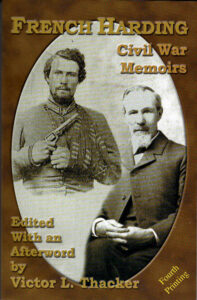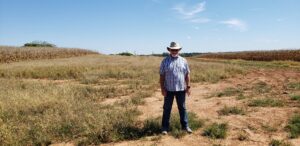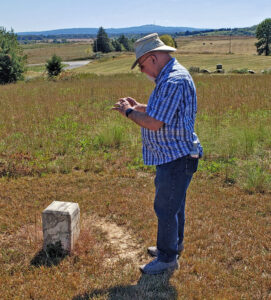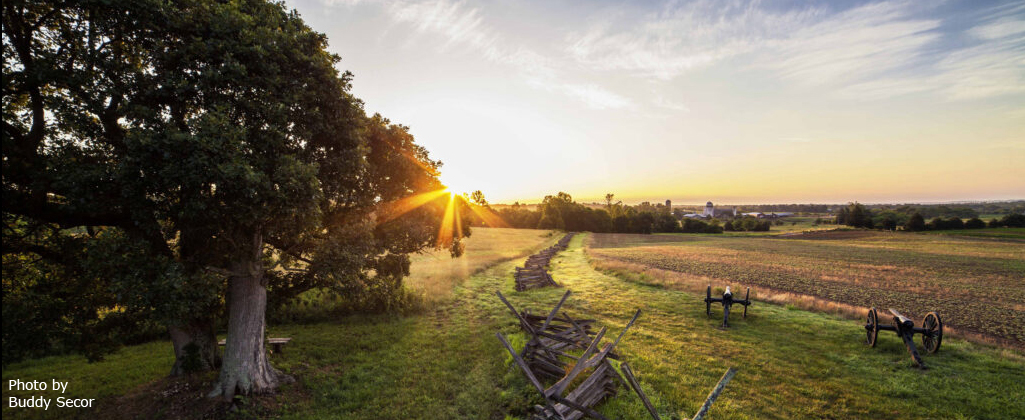This is the 3rd installment of a series of four memorable tours given at Cedar Mountain Battlefield in 2019. A descendant’s interest in his ancestor prompts a guided tour focusing on the 31st Virginia.
 On September 25, 2019, Friends of Cedar Mountain vice president Michael Block hosted Dr. Victor L. Thacker, retired Air Force Colonel, on a visit to the Cedar Mountain battlefield. Mike contributed the following tour report.
On September 25, 2019, Friends of Cedar Mountain vice president Michael Block hosted Dr. Victor L. Thacker, retired Air Force Colonel, on a visit to the Cedar Mountain battlefield. Mike contributed the following tour report.
Victor was most interested in the 31st Virginia Infantry, as his great great uncle French Harding played a prominent role in the August 9 fight. The 31st Virginia was part of Jubal Early’s Brigade, Ewell Division; all part of Stonewall Jackson’s Army of the Shenandoah.
After introductions, we traveled south to the ford at Crooked Run, where Harding and the Army of the Shenandoah crossed as they advanced towards the eventual fight. The ford is on private property, with very limited access.
We continued to follow the Confederate march to a point just west of the battlefield, where Early’s command briefly rested along the banks of one of Crooked Run’s feeder streams, then marched on to the battlefield.
At the start of the day’s fighting, Early was ordered to advance and clear out the Federal cavalry, who were maintaining a picket line. Early’s Virginians advanced and made short work of the horse soldiers, clearing the western end of the field and allowing Jackson’s men to deploy.
We began our tour of the fighting again on private property (with permission), where the 31st Virginia fought. Early’s brigade aligned to the south of modern US Route 15 and spent the majority of the day fighting near the Crittenden Lane, first on a rise to the east, and later in the fields below the lane. Victor was knowledgeable about the fight and the role the 31st played.

In September 2019, much like August 1862, the land was in corn. We were able to find viewing points along the field as Early’s portion of the fight was discussed. In that late 1862 afternoon, combined advances by three Federal Brigades broke portions of the Confederate lines, including Early’s position on this rise. The 31st retreated about 200 yards into a wooded hollow and that is where French Harding had his moment.
Jubal Early, in his after-action report, stated the event thusly: “A body of men from the Thirty-First Virginia Regiment, around their colors, advancing the same way, attracted my attention by their gallantry. I was particularly struck by the bravery exhibited by the color-bearers, of these two regiments (the 13th being the other), who, with these small bodies of men around them, were waving their flags in the very front, as if to attract a fire upon them, and advancing all the well.” One of those color-bearers was French Harding.1
Harding’s memoirs were published in 2000 and tell the same story, from his perspective. “My Immediate later actions is to me, now inexplicable. Probably I then had no reason for it, other than the knowledge that some of my comrades had been left dead, and others wounded, on the battlefield. Be that as it may, one of the color guard – Martin Mulvey – had brought up the regimental flag; which I at once caught up and waved, called the boys to follow me, and without orders, started back to meet the enemy.”2
It is always a moving experience to walk significant family ground and it was not different for Victor Thacker. As a guide I draw profound pleasure from walking with descendants, recounting their personal histories on the spot where that history occurred.
We followed French and the 31st Virginia as they advanced across the corn toward the Culpeper Court House – Orange Courthouse road, as they chase the broken Federal ranks and where the fighting for this particular unit ended.

Our last stop was The Point, where the recovered Grimsley Marker for Early’s Brigade is now located. It was a bright clear early afternoon, and easy for both of us to look at the rolling land, practically unchanged in 157 years, to reflect on the events and fortunes of all involved that day. Harding French survived the Battle of Cedar Mountain without injury, but was wounded in the arm three weeks later in the Thunder at Ox Hill.
French Harding survived that wound and the war.
NOTES:
1. Official Records, Series 1, Vol. 12, Part 2, p 233.
2. Thacker, Victor K., ed., French Harding Civil War Memoirs, (Parsons, WV, McClain Printing Company, 2000), p 60-61.
 Print This Post
Print This Post

